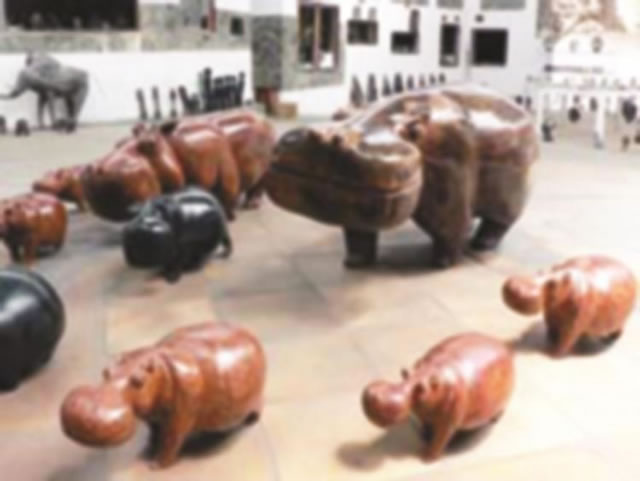Intellectual property rights and art

 Artists have a reputation of being unique. But in spite of their eagerness to attain exclusive status, there are basic artistic and literary statutes that they need to observe to ensure appropriate protection of their products.Back in 2007, sculptor Dominic Benhura filed a lawsuit against a gallery owner Newman Chiadzwa over copyright violations.
Artists have a reputation of being unique. But in spite of their eagerness to attain exclusive status, there are basic artistic and literary statutes that they need to observe to ensure appropriate protection of their products.Back in 2007, sculptor Dominic Benhura filed a lawsuit against a gallery owner Newman Chiadzwa over copyright violations.
The legal battle had started over seven years before when the multiple award-winning sculptor realised that the gallery owner, conniving with a lesser known artist, made and sold artworks they alleged had been created by Benhura.
Benhura is not the first or the only artist to fall prey to piracy. Every day, pirated music copies are sold on street corners.
All is not lost though. Zimbabwe has legislation against the violation of copyright for artistic works. Under the country’s Copyright and Neighbouring Act, it is an offence for one to copy or reproduce artistic works. Artistic works under the law include any form of graphic, photograph, sculpture or collage, irrespective of its artistic quality.
The law says the author, who is defined as the person responsible for producing the original artwork reserves the right for any reproductions or alterations of such product, regardless of whether or not it meets any artistic set standard or level.
This means that no one has the right to replicate your primary school child’s work without due consent.
Other artworks covered under the law include architectural work, broadcasts and computer programs. Additionally, Zimbabwe is a signatory to the Berne Convention for the Protection of Literary and Artistic Works (1886). This law is more multifaceted in that it also covers artworks from other countries who are Berne signatories.
In fact, the Berne Convention for the Protection of Literary and Artistic Works is guided by three basic principles. The first is that artworks created or made available in one member state of the convention must be given as much protection in other member countries as those granted to nationals of those states. This means that, since the United States of America is a Berne Convention signatory, Oliver Mtukudzi’s music enjoys as much protection in the US as, say Beyonce’s. The same applies to foreign literary and artistic works made available in Zimbabwe.
Secondly, the convention states that such protection should not be subject to legislative formalities, but must instead be automatic. Lastly, protection of work from a fellow signatory state is independent of protection in the country of origin. In Zimbabwe, as is the case in most countries, protection of artworks covers the full life of the author, plus 50 years after his/her death. However, if the work was created under a pseudonym, protection expires 50 years after the day it was created.
A good number of artists are oblivious of such laws and are either victims or violators without knowledge. One such artiste is Mic Inity, a supposed reggae singer who spent about an hour on stage during the beer festival in Harare a fortnight ago. He sang several hits that belong to reggae greats such as Bob Marley, Capleton, Vybz Kartel and Sizzla.
Drawing inspiration from fellow artistes is one thing, but copying word for word, using identical beats to those done elsewhere is quite another. The lack of originality extends to sculptures and fine artists practising roadside and airport art. There, one design that “sells” to tourists and other visitors is replicated into several identical products and sold en masse.
The practice reduces the works to mere artifacts, such as mitsvairo or reed mats because the notion of originality is lost and replaced by a scheme driven by nothing but the need to extract as much from the passers-by as possible.
Regrettably, the tourists go back home with “artworks” that they think represent Zimbabwean art when instead all they carry back is one of the top five money-making schemes of “pseudo-artists” that acutely lack inventiveness.
Products that fall into this category include animal sculptures, “sunset” paintings and some products that suggest “Africanness”.
The dilemma is on what comes first for the artist; retaining originality or making money. In the trying times our country is coming from, most artists chose the latter. In Newman Chiadzwa and accomplices’ case and in many other instances, artistic expression is compromised in favour of a quick buck.
It is by no means a coincidence that the number of roadside and airport artists exponentially increased during the time that everyone was starting to search hard for the elusive foreign currency. A market for original artworks does exist.
There can be no reason for artists, professional or armature, to demote their talents and present products that they did not originate.
It is a pity because most are very talented but fail to develop their styles to a point where their artworks are appreciated simply for their originality. What lacks with “copy artists” is patience. Developing a distinct style, choosing specific subjects to work in and selecting preferred tools and media to work with takes a considerable amount of time and that requires staying power.
Choosing money over that compulsory development, or relegating the profession to a part-time job while working on other things hinders development.
The problem is not peculiar to Zimbabwe only. Fake replica European football jerseys are made elsewhere by pseudo-fashion designers that see Zimbabwe and other developing countries as a ready market for the products.
The Zimbabwean market is full of such products.
There are even fakes for the “original” fakes! Their conduct is not due to laziness, but misplaced priorities by artists who place financial rewards above all else.
The fashion designers developing duplicate wares could be more relevant if they invented their own designs. What makes a work of art powerful is its inimitable qualities and once that is no longer a factor, the product loses all its eminence. Some artists violate copyright laws out of ignorance and those need to be educated on the parameters they should work within.
Others who knowingly “borrow” whole ideas from existing works are no different from other criminals and should be prosecuted under the country’s copyright laws.
There are no limits to critical thinking in art, it is a wonder why some supposed artists fail to develop artworks based on fresh ideas. It is possible that some are just in the wrong profession.







Comments